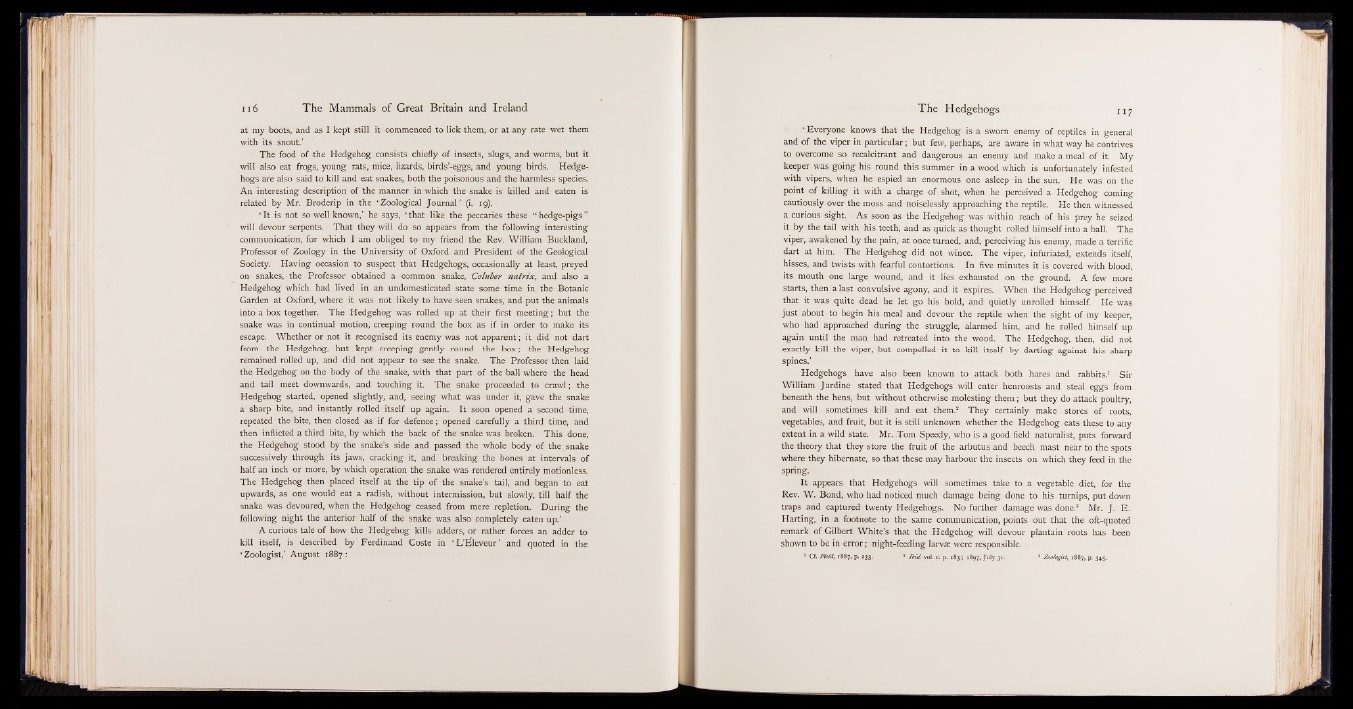
at my boots, and as I kept still it commenced to lick them, or at any rate wet them
with its snout.’
The food of the Hedgehog consists chiefly of insects, slugs, and worms, but it
will also eat frogs, young rats, mice, lizards, birds’-eggs, and young birds. Hedgehogs
are also said to kill and eat snakes, both the poisonous and the harmless species.
An interesting description of the manner in which the snake is killed and eaten is
related by Mr. Broderip in the ‘ Zoological Journal’ (i. 19).
‘ It is not so well known,’ he says, ‘ that like the peccaries these “ hedge-pigs ”
will devour serpents. That they will do so appears from the following interesting
communication, for which I am obliged to my friend the Rev. William Buckland,
Professor of Zoology in the University of Oxford and President of the Geological
Society. Having occasion to suspect that Hedgehogs, occasionally at least, preyed
on snakes, the Professor obtained a common snake, Coluber natrix, and also a
Hedgehog which had lived in an undomesticated state some time in the Botanic
Garden at Oxford, where it was not likely to have seen snakes, and put the animals
into a box together. The Hedgehog was rolled up at their first meeting; but the
snake was in continual motion, creeping round the box as if in order to make its
escape. Whether or not it recognised its enemy was not apparent; it did not dart
from the Hedgehog, but kept creeping gently round the box; the Hedgehog
remained rolled up, and did not appear to -see the snake. The Professor then laid
the Hedgehog on the body of the snake, with that part of the ball where the head
and tail meet downwards, and touching it. The snake proceeded to crawl; the
Hedgehog started, opened slightly, and, seeing what was under it, gave the snake
a sharp bite, and instantly rolled itself up again. It soon opened a second time,
repeated the bite, then closed as if for defence; opened carefully a third time, and
then inflicted a third bite, by which the back of the snake was broken. This done,
the Hedgehog stood by the snake’s side and passed the whole body of the.snake
successively through its jaws, cracking it, and breaking the bones at intervals of
half an inch or more, by which operation the snake was rendered entirely motionless.
The Hedgehog then placed itself at the tip of the snake’s tail, and began to eat
upwards, as one would eat a radish, without intermission, but slowly, till half the
snake was devoured, when the Hedgehog ceased from mere repletion. During the
following night the anterior half of the snake was also completely eaten up.’
A curious tale of how the Hedgehog kills adders, or rather forces an adder to
kill itself, is described by Ferdinand Coste in ‘ L ’Eleveur’ and quoted in the
‘ Zoologist,’ August 1887:
‘ Everyone knows that the Hedgehog is a sworn enemy of reptiles in general
and of the viper in particular; but few, perhaps, are aware in what way he contrives
to overcome so recalcitrant and dangerous an enemy and make a meal of it. My
keeper was going his round this summer in a wood which is unfortunately infested
with vipers, when he espied an enormous one asleep in the sun. He was on the
point of killing it with a charge of shot, when he perceived a Hedgehog coming
cautiously over the moss and noiselessly approaching the reptile. He then witnessed
a curious sight. As soon as the Hedgehog was within reach of his prey he seized
it by the tail with his teeth, and as quick as thought rolled himself into a ball. The
viper, awakened by the pain, at once turned, and, perceiving his enemy, made a terrific
dart at him. The Hedgehog did not wince. The viper, infuriated, extends itself,
hisses, and twists with fearful contortions. In five minutes it is covered with blood,
its mouth one large wound, and it lies exhausted on the ground. A few more
starts, then a last convulsive agony, and it expires. When the Hedgehog perceived
that it was quite dead he let go his hold, and quietly unrolled himself. He was
just about to begin his meal and devour the reptile when the sight of my keeper,
who had approached during the struggle, alarmed him, and he rolled himself up
again until the man had retreated into the wood. The Hedgehog, then, did not
exactly kill the viper, but compelled it to kill itself by darting against his sharp
spines.’
Hedgehogs have also been known to attack both hares and rabbits.1 Sir
William Jardine stated that Hedgehogs will enter henroosts and steal eggs from
beneath the hens, but without otherwise molesting them; but they do attack poultry,
and will sometimes kill and eat them.2 They certainly make stores of roots,
vegetables, and fruit, but it is still unknown whether; the Hedgehog eats these to any
extent in a wild state. Mr. Tom Speedy, who is a good field naturalist, puts forward
the theory that they store the fruit of the arbutus and beech mast near to the spots
where they hibernate, so that these may harbour the insects on which they feed in the
spring.
It appears that Hedgehogs will sometimes take to a vegetable diet, for the
Rev. W. Bond, who had noticed much damage being done to his turnips, put down
traps and captured twenty Hedgehogs. No further damage was done.8 Mr. J. E.
Harting, in a footnote to the same communication, points out that the oft-quoted
remark of Gilbert White’s that the Hedgehog will devour plantain roots has been
shown to be in error; night-feeding larvae were responsible.
1 Cf. Field, 1887, p. 233. * Ibid. vol. c. p. 183; 1897, July 31. 3 Zoologist; 1887, p. 345.